Air Force, United States, is the branch of the U.S. armed forces responsible for most military operations in the air and in space. Air Force reconnaissance (information-gathering) satellites and aircraft constantly scan the earth for signs of hostile activity. The Air Force is ready to attack immediately with conventional or nuclear weapons. The Air Force also supports ground troops in battle and protects them from air attack. Air Force transport planes deliver troops and supplies.
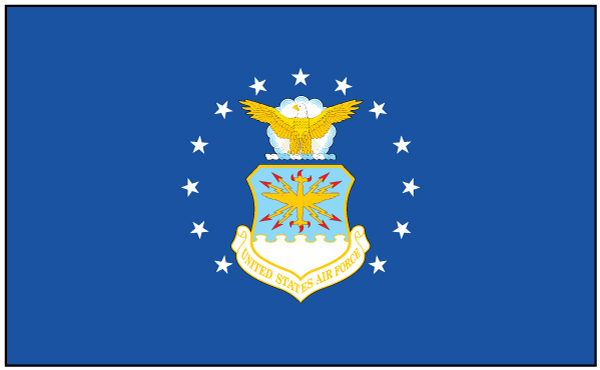
Because the Air Force needs to use advanced technology, it has a large research and development organization, with laboratories and testing centers throughout the United States. In addition, thousands of civilian scientists and engineers at universities and in corporations conduct research for the Air Force. The Air Force has cooperated with the National Aeronautics and Space Administration (NASA) to send astronauts and satellites into space. The Air Force also tracks hurricanes, forecasts weather, and carries help to disaster victims.

The Air Force has about 325,000 men and women on active duty throughout the world. In addition, about 175,000 people serve in the Air Force Reserve or the Air National Guard. The Air Force also employs about 145,000 civilians. The Air Force has more than 5,000 active aircraft and about 400 intercontinental ballistic missiles (ICBM’s), long-range missiles that can reach targets up to 9,200 miles (15,000 kilometers) away.
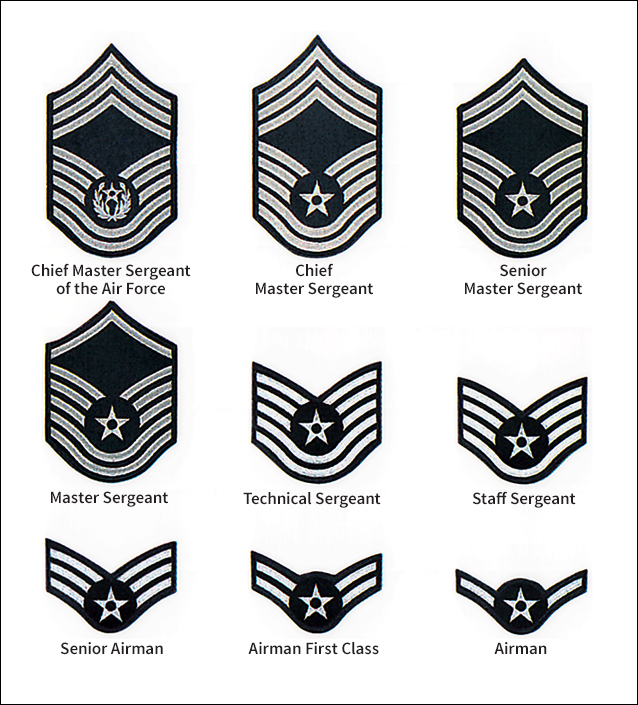
The Air Force’s official colors are ultramarine blue and Air Force yellow. Its official song is the “United States Air Force Song,” which begins, “Off we go into the wild blue yonder.”
Congress created the Air Force in 1947 by reorganizing the Army Air Forces as a separate branch. The Army Air Forces developed from an Aeronautical Division that the Army Signal Corps set up in 1907.
Life in the Air Force
Men and women who serve in the United States Air Force give up some of the freedoms they protect for their country. They must go wherever they are sent, even on missions that may put their lives in great danger. The United States Air Force has about 85 major bases, some of which are overseas. Most Air Force members serve abroad at some time.

Recruit training.
After enlisting, recruits receive eight and a half weeks of basic military training at Lackland Air Force Base near San Antonio. Through marching, exercise, and classroom studies, recruits learn about teamwork in a military environment. Graduates of basic training learn a job specialty. They may reenlist after their minimum four or six years of service.
Officer training.
The Air Force offers several programs for training officers. The programs include those of the Air Force Academy near Colorado Springs, Colorado; Air Force Reserve Officers Training Corps (AFROTC) in colleges and universities; and the Officer Training School (OTS) at Maxwell Air Force Base in Alabama.
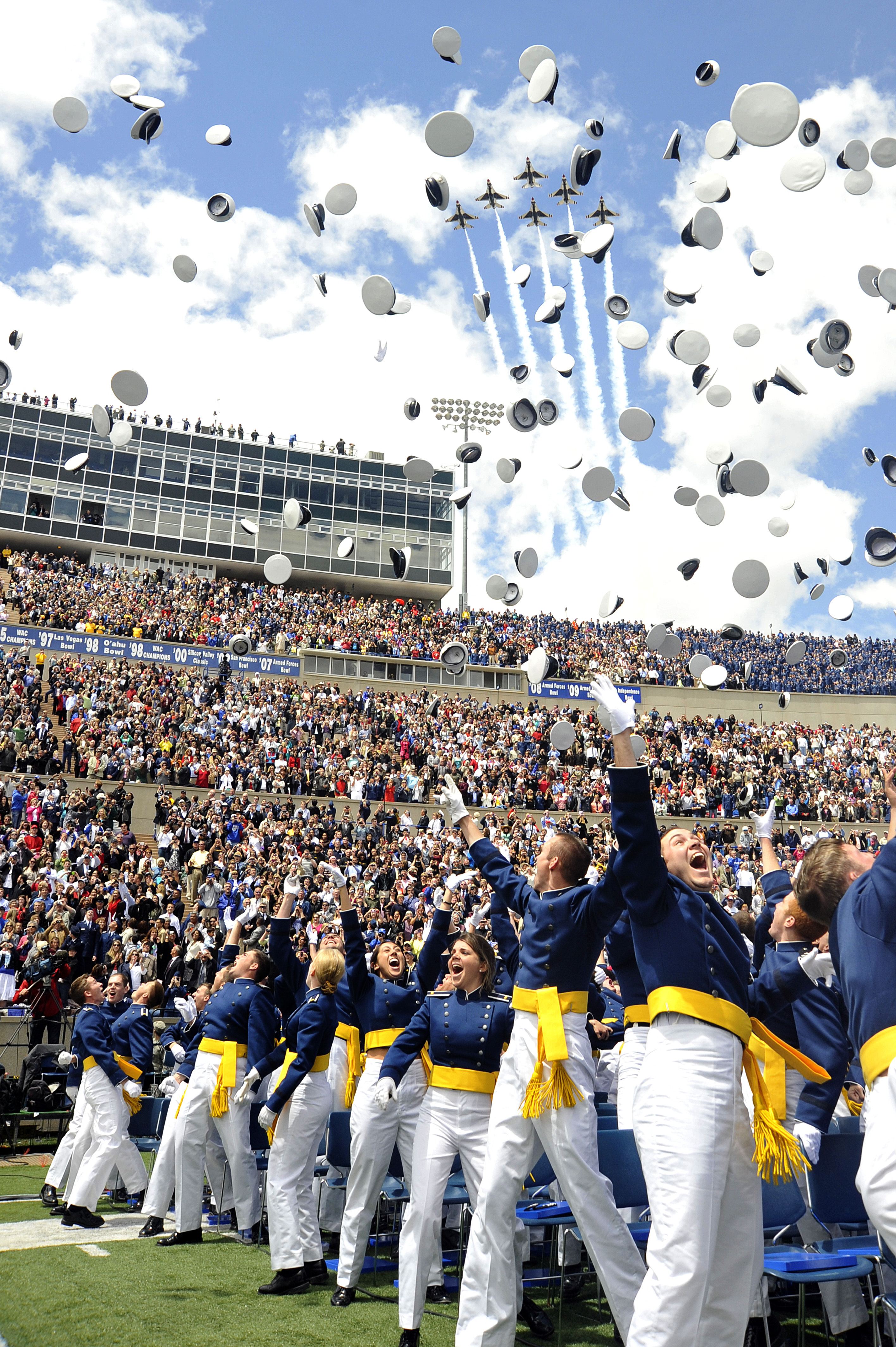
Air Force women
are trained, administered, and paid under the same policies as are Air Force men. Before the establishment of the Air Force in 1947, many members of the Women’s Army Corps (WAC) were assigned to the Army Air Forces.
During World War II (1939-1945), more than 40,000 “Air Wacs” served at air bases in the United States and in other parts of the world. More than 1,000 civilians served as Women Airforce Service Pilots, also known as WASP’s, under the leadership of aviation pioneer Jacqueline Cochran. The WASP’s flew aircraft from factories to air bases in the United States.
In 1948, women became a permanent part of the armed forces. Women in the Air Force became known as WAF’s. The Air Force dropped this term in the 1970’s. The term airman is now used for all Air Force enlisted military personnel. About one-fifth of Air Force military personnel are women.
Careers in the Air Force
provide opportunities for advanced education and promotion. Enlistment may prepare a person for a civilian job or an Air Force career. The Air Force offers jobs in many career fields. Applicants must be at least 17 years of age and not older than 34. They also must pass the Air Force’s physical and written examinations. Air Force military personnel may retire after 20 years of service. But many personnel stay on active duty for 30 years and some even longer.
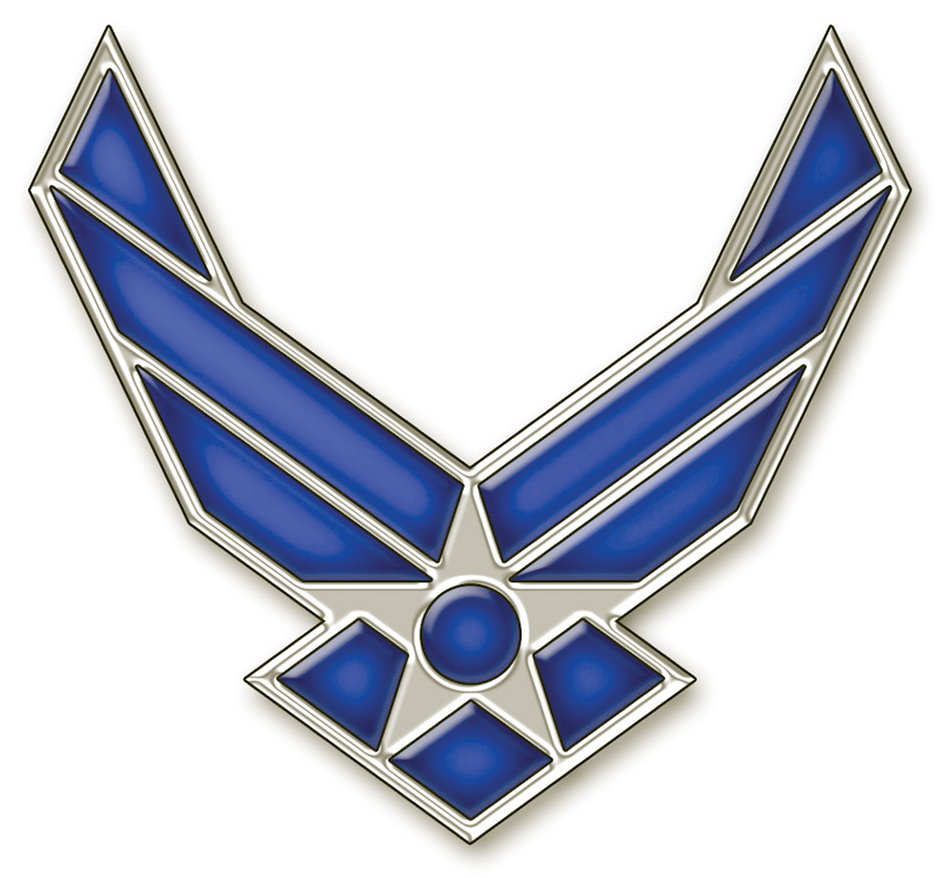
Members of the Air Force receive a base pay that is determined by their rank and length of service. They may receive extra money for special tasks, such as flying a plane or taking part in combat. The Air Force also pays for quarters (housing) or subsistence (food) when airmen are unable to live or eat on base. All Air Force personnel on active duty are eligible for 30 days’ leave (vacation) a year. The Air Force provides free medical care to airmen and their families.
The purpose of the Air Force
Since World War I (1914-1918), the most powerful countries have built large air forces. Air forces are the best defense against enemy airpower, and they can do great harm to enemy ground and sea forces. Air forces can attack targets anywhere in the opening minutes of a war.
Defense and deterrence.
The people of every nation understand the terrible destructive power of nuclear and conventional weapons. As long as a potential enemy is unwilling to risk an exchange of attacks, the Air Force serves its primary purpose—to deter war. However, the Air Force must remain on alert for an enemy missile or bomber attack and must be prepared to respond to such an attack.
The U.S. Air Force has developed an extensive warning system to give the United States time to launch its offensive air weapons before they could be destroyed by a missile or bomber attack. The U.S. early warning system is managed by the North American Aerospace Defense Command (NORAD), which has headquarters at Peterson Space Force Base near Colorado Springs. The most important parts of the system are reconnaissance satellites that orbit over various parts of the world.
On the ground, the Solid State Phased Array Radar System (SSPARS) in Alaska, California, Massachusetts, Greenland, and the United Kingdom warns of intercontinental ballistic missiles (ICBM’s) that might be headed for the United States. Enemy bombers or cruise missiles flying over Alaska or Canada might be detected first by the North Warning System line of radars. Cruise missiles are jet-powered missiles that fly at low altitudes to avoid radar detection. A radar system in Maine can detect aircraft and cruise missiles approaching the east coast of the United States.
The Air Force also carries radar aboard its Airborne Warning and Control System (AWACS) planes. In addition to performing its early warning function, an AWACS plane can fly to another part of the world and control U.S. air strikes. AWACS planes flew such missions during the Persian Gulf War of 1991 and the Iraq War (2003-2011). 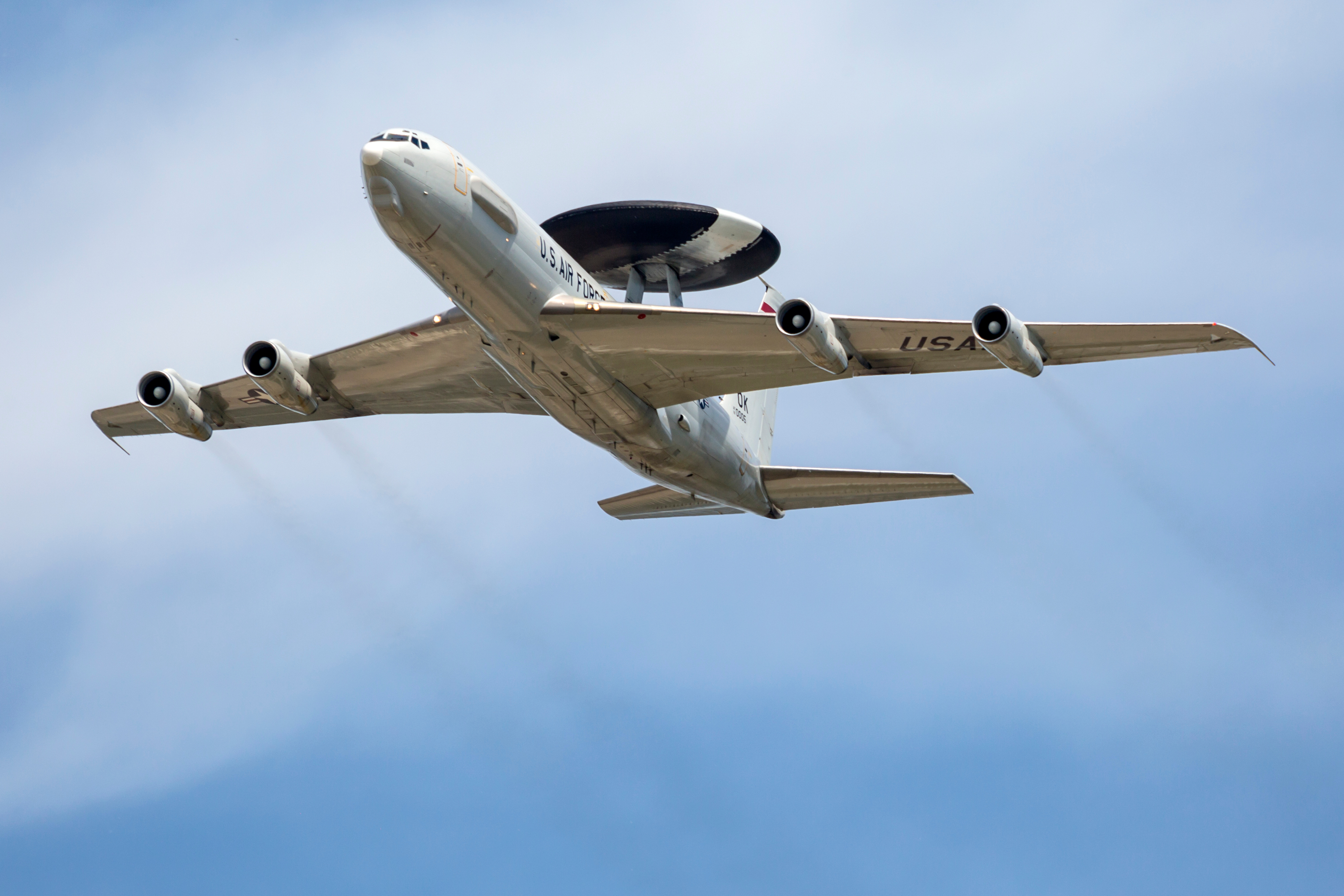
Offense.
The most important use of the Air Force during war is to attack the enemy. Air attack can hit unexpectedly, at long range, and with devastating power. Each flight a combat plane makes against the enemy is called a sortie. An attack by one or more planes is a combat mission. If 10 planes fly in a group, the group flies 1 combat mission, but 10 sorties.
Tactical air attacks
Tactical air attacks are the direct help given to ground or sea units in battle. Tactical air units fight to control the air over a battle area by destroying planes in the air and on the ground. They attack enemy reserve troops and supplies to interdict them—that is, prevent them from reaching the field of battle. They provide close support for friendly ground troops, attacking specific targets to help the troops. Close support is direct intervention in a ground battle.
Strategic air attacks
hit far behind the battle lines. Such attacks destroy the enemy’s industries, war materials, power grid, and communications network, including internet, radio, telephone, and television. They also ruin the enemy’s transportation system so troops and supplies cannot be moved into battle. Strategic air attacks are designed to destroy the enemy’s ability to make war, or its will to fight.
Peacetime emergencies.
Prompt action by the Air Force may at times relieve emergencies that are short of war. The Berlin Airlift was a good example of such action. In 1948, the Soviet Union tried to force the Allies out of West Berlin with a ground blockade. The plan was defeated when the U.S. Air Force, the French Air Force, and the Royal Air Force of the United Kingdom created an effective aerial supply line to the city. The U.S. Air Force also charts the courses of hurricanes and gives advance warning to people living in the path of such storms. In times of disaster, the Air Force has flown emergency medical supplies into the affected areas.
Planes and weapons of the Air Force
The United States Air Force has many kinds of aircraft. A few are driven by propellers, but jet engines drive most Air Force planes today. Many planes carry only a pilot. Others have a crew of several members that may include a copilot, navigator, and flight engineer. Some aircraft are guided only by electronic devices. See Aircraft, Military.
Planes of the Air Force are designated by both letters and numbers. A letter in front of the numbers refers to the basic mission of the plane, and the numbers designate the model. Basic missions include A, attack; B, bomber; C, cargo transport; F, fighter; H, helicopter; K, tanker; M, multipurpose; R, reconnaissance; and T, trainer. For example, an F-15 is a fighter aircraft.
The original designation for fighters was P, which stood for pursuit. These planes were initially devised to pursue and destroy enemy bombers. Pursuit planes were later reclassified as fighter planes. The P-51 Mustang was a famous pursuit plane during World War II.
A letter following the numbers indicates a general modification of the design. The original design is designated A, but often this letter is not used. The first modification is designated B; the second, C; and so on. Thus, the fourth modification (the fifth general design) of the F-15 is the F-15E. Some designations have an additional letter indicating a special modification. This letter appears in front of what would otherwise be the first letter. For example, an AC-130 is a C-130 to which guns have been added to convert it to an attack aircraft. 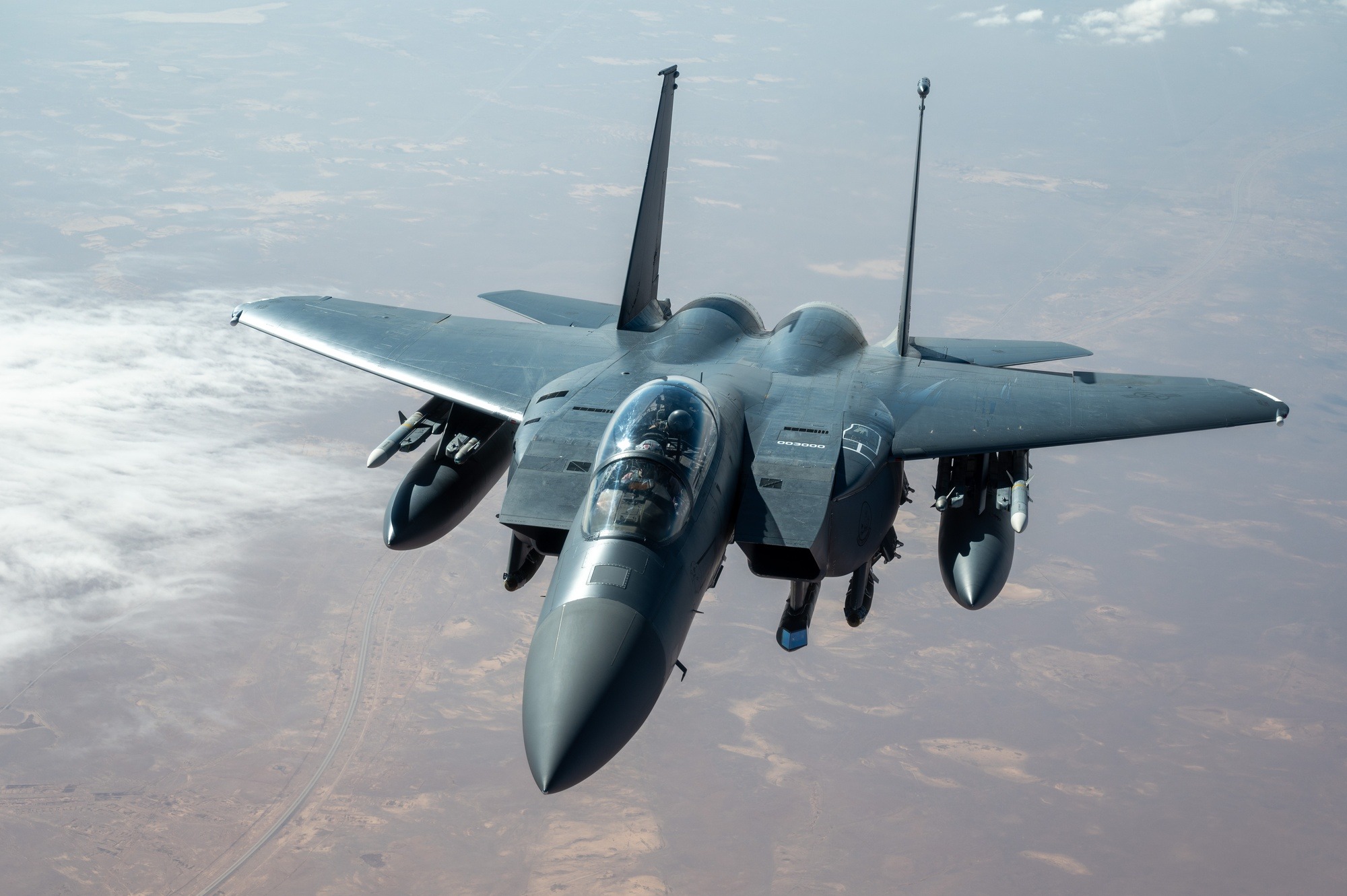
Bombers
drop explosives on enemy targets. These planes are equipped with radar and bombsights to find the target and direct bombs to it. The navigator guides the pilot over the target, then releases the bomb. Bombers also launch missiles. The B-52 is the oldest American bomber in service. The B-52’s maximum range without refueling is more than 8,800 miles (14,000 kilometers), and its top speed is nearly 650 miles (1,050 kilometers) per hour. American bombers also include the B-1, which is smaller than a B-52 but carries a heavier bomb load. The B-1 has a top speed of 950 miles (1,530 kilometers) per hour. A third type of bomber, the B-2 “stealth” bomber, is a sleek plane designed to be nearly invisible to radar. However, the B-2 sacrifices speed and payload for stealth. A bomber’s payload is the combined weight of its fuel and weapons. 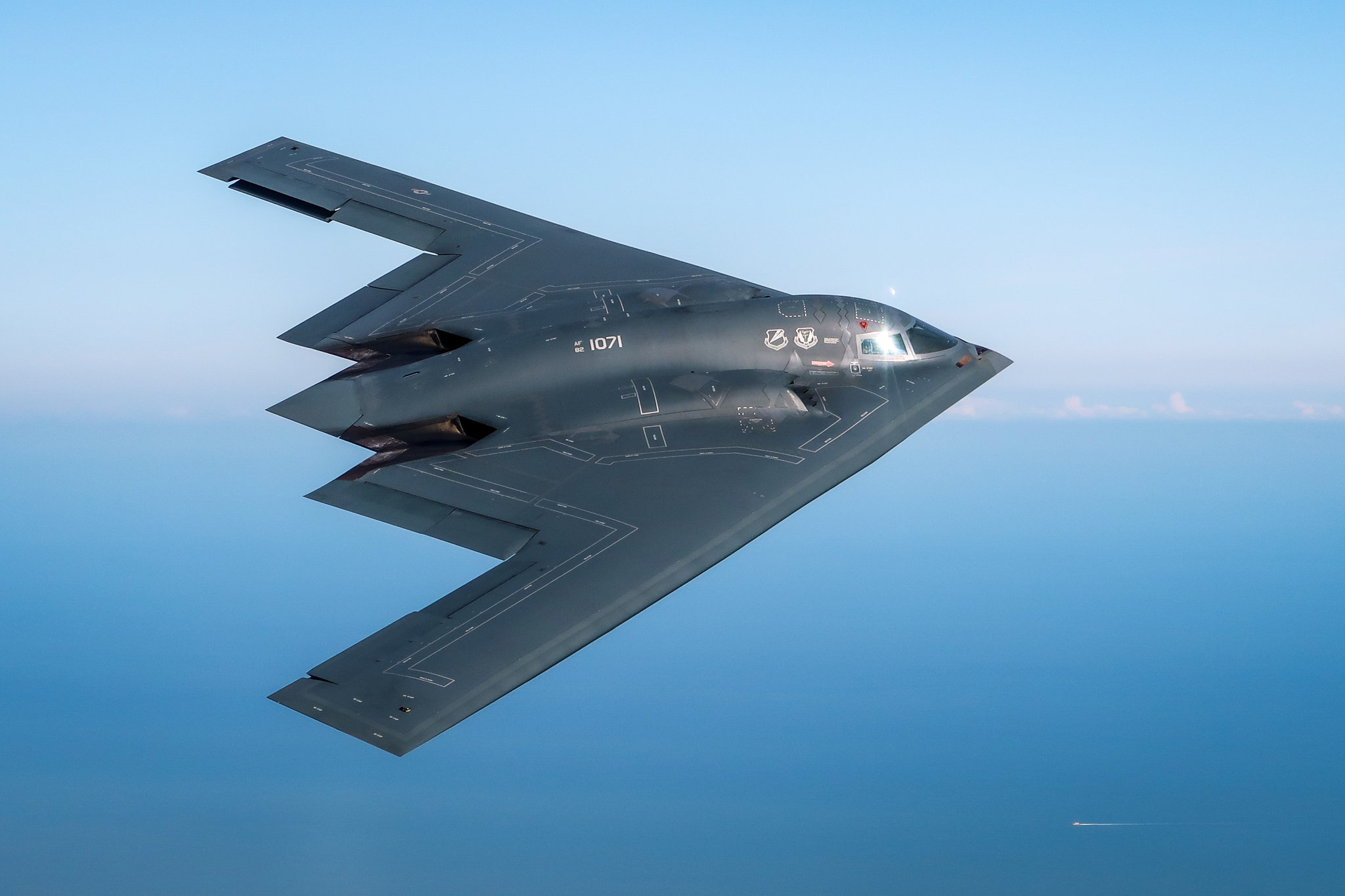
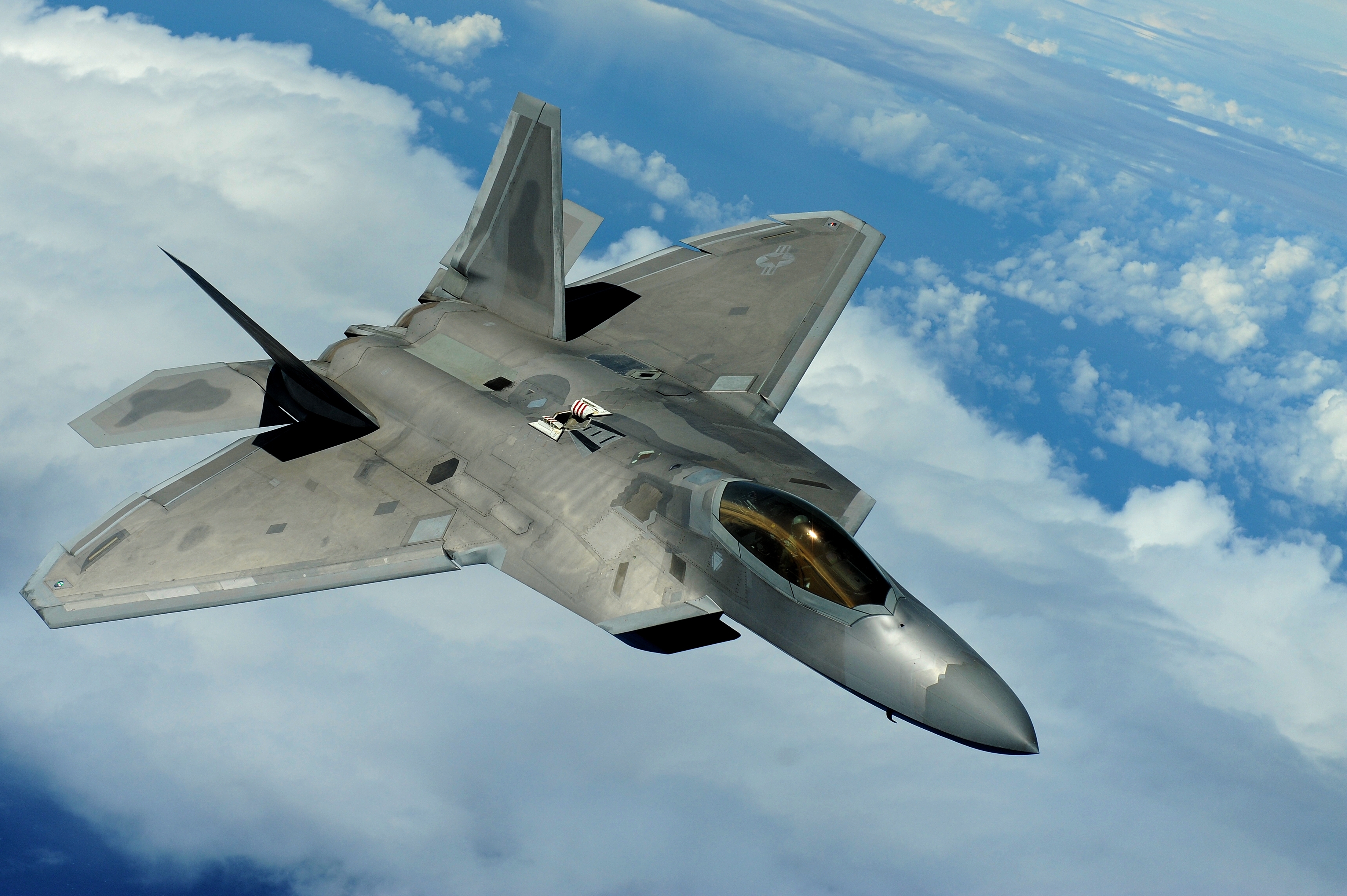
Fighters
shoot down enemy aircraft and attack ground targets. They are smaller and generally faster than bombers. However, many fighters perform bombing missions. In fact, the leading precision bombers in the Iraq War were F-117, F-111, and F-15E fighters. The F-117 “stealth” fighters penetrated heavy air defenses around Baghdad, Iraq, without being hit. The two-seat F-15E lacks the “stealth” of the F-117, but it is faster and can reach a speed of Mach 2.5. Mach 2.5 is 2.5 times the speed of sound. Sound travels about 760 miles (1,220 kilometers) per hour at sea level. Equally fast is the single-seat F-15C, which has been the Air Force’s best fighter for shooting down enemy aircraft. Lighter and slower than the two-engine F-15 is the single-engine F-16, which can be used in air-to-air combat or against ground targets. The Air Force’s newest fighters, the F-22 and F-35, combine stealth and speed. Their body structures, computers, and electronics are more advanced than those of older fighters.
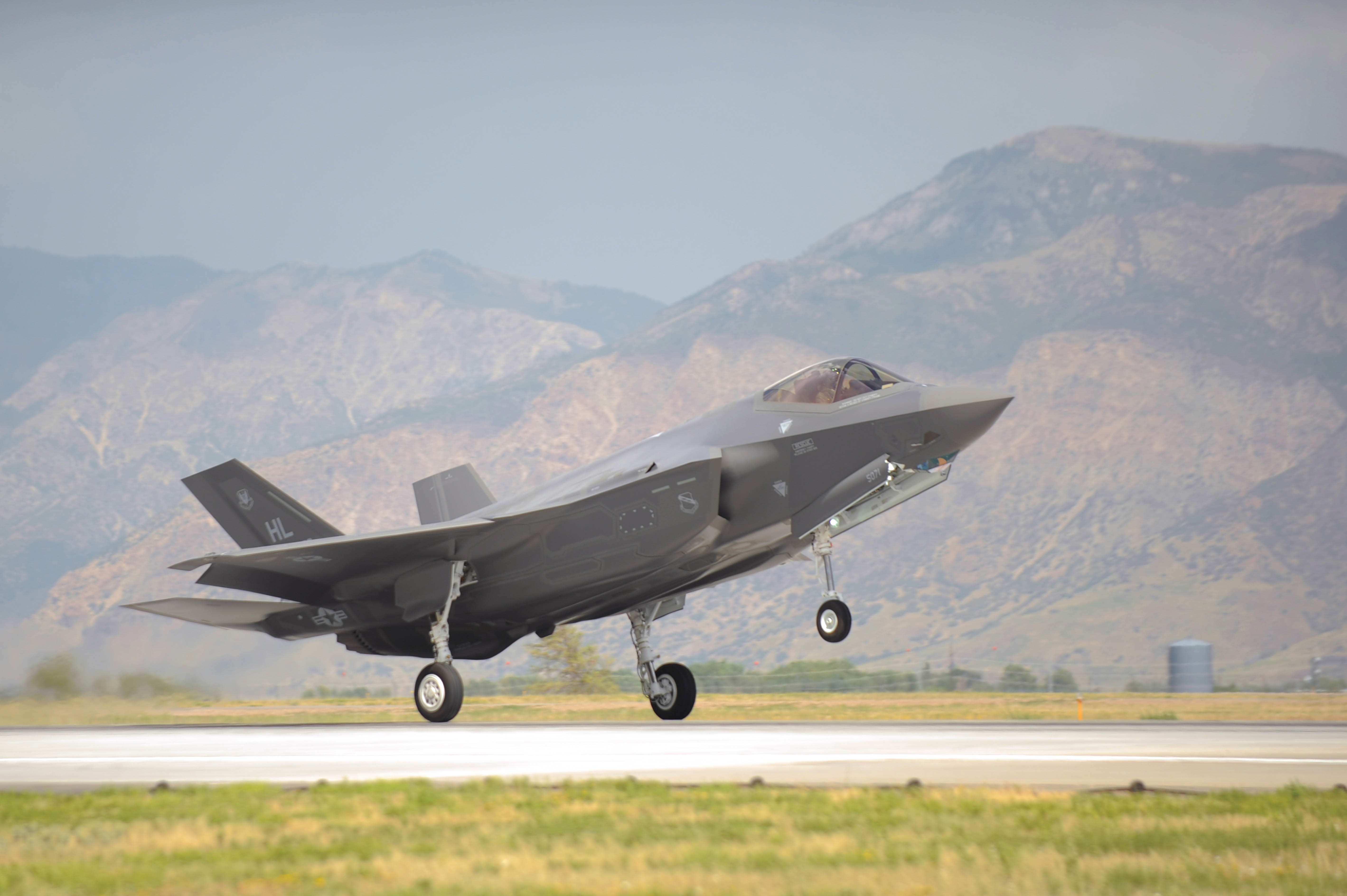
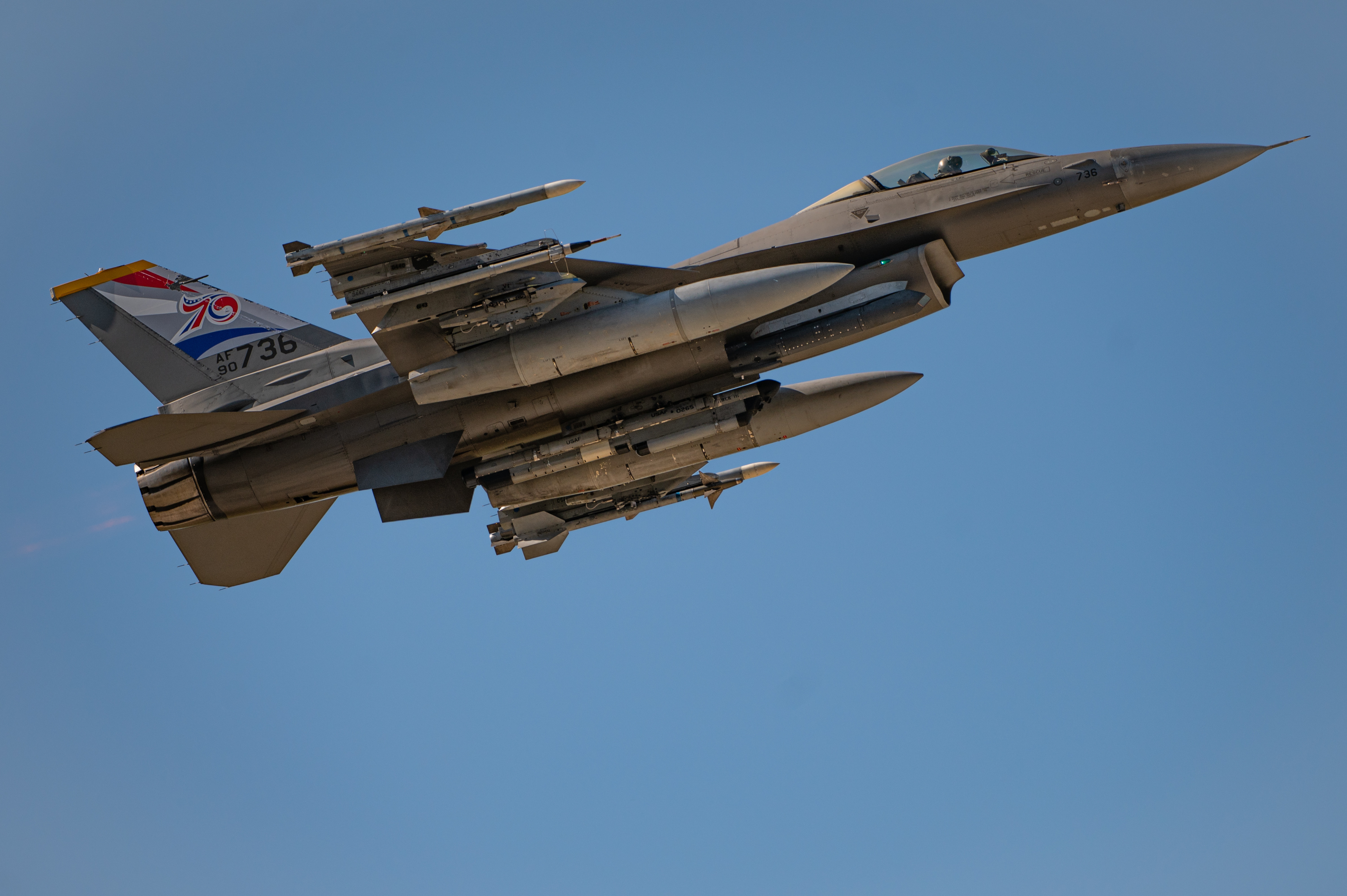
Other aircraft
include attack and reconnaissance planes, tankers, and transports. Attack planes, such as the A-10, are designed to provide low-flying air support for ground troops, particularly against armored targets. The A-10 has an inefficient and obsolete design, but is still flown partly because of its performance in earlier wars. Reconnaissance planes observe and photograph enemy forces and installations. Tanker aircraft refuel other planes in flight.
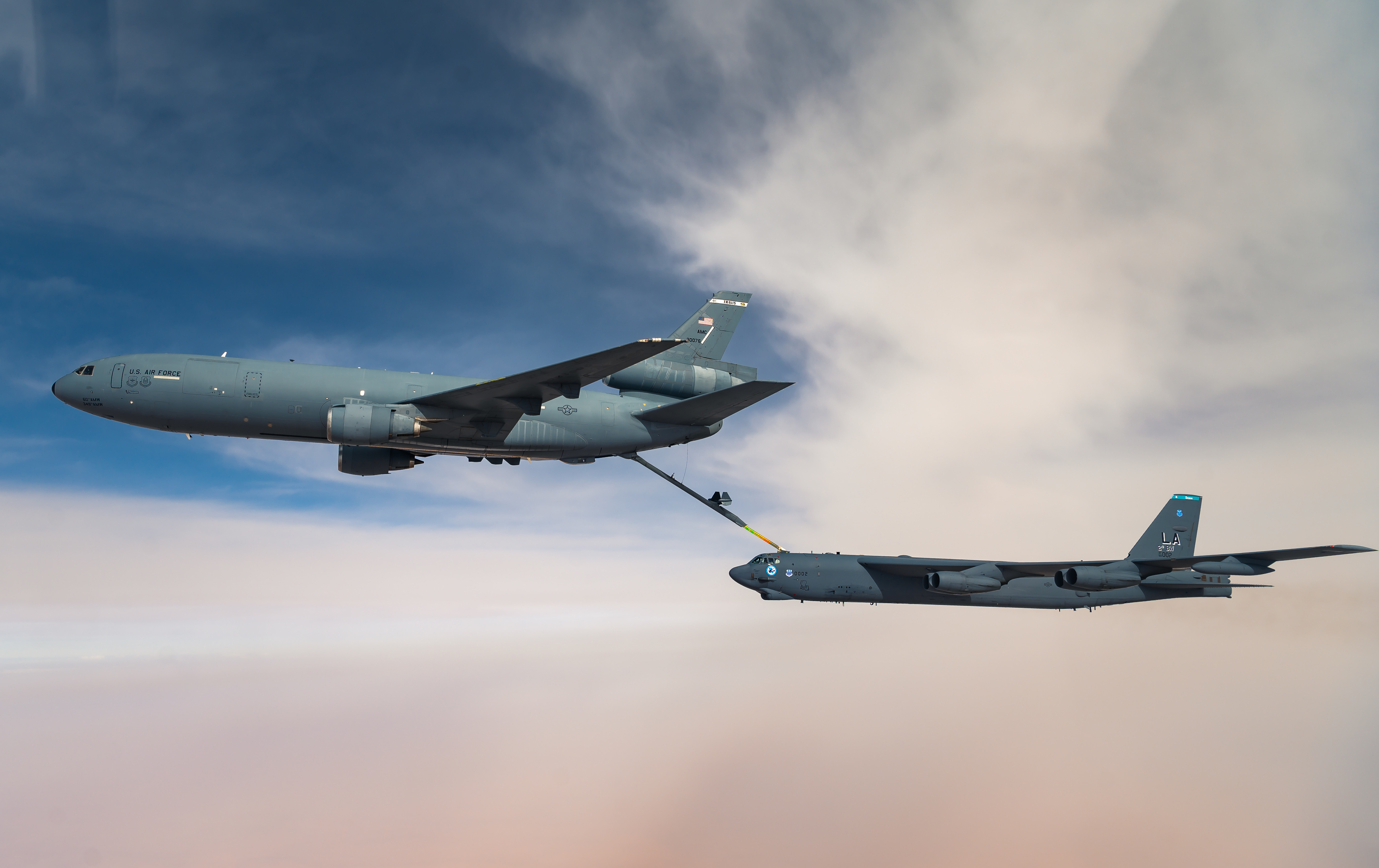
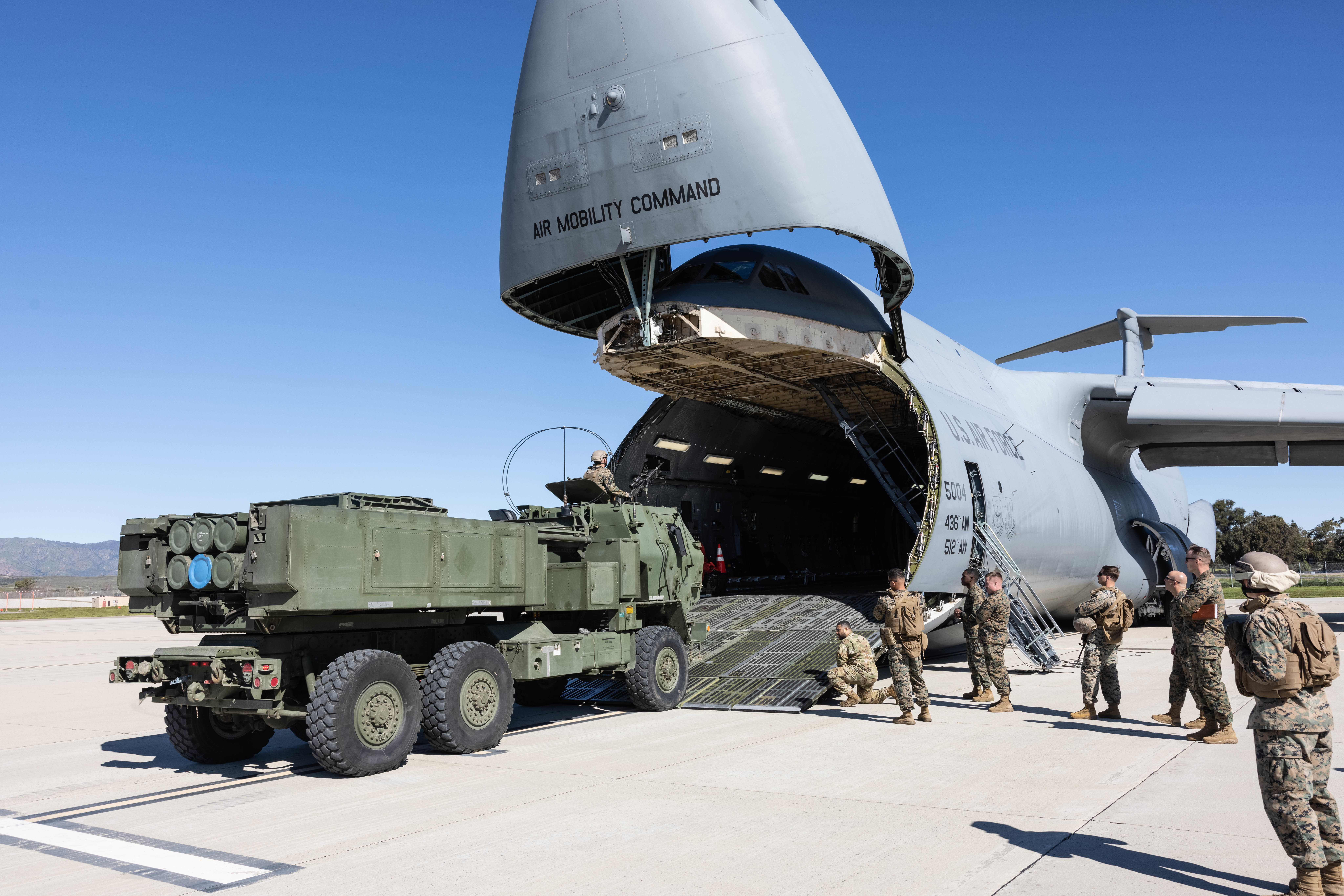
Transport aircraft carry personnel and equipment and can evacuate wounded soldiers in battle. The C-5 Galaxy can carry tanks or helicopters. The C-5 and the smaller C-141 can fly long distances. The C-17 can carry a bigger load and land on a shorter runway than the C-141 can. The C-130 Hercules is used on shorter flights and can land on primitive dirt airstrips.
Remotely piloted aircraft called drones can execute military operations without putting pilots at risk. The MQ-1 Predator drone can perform reconnaissance or attack enemy ground targets. The Q denotes that it is a remotely piloted aircraft. A pilot flies the drone via satellite from a ground control station that can be thousands of miles away. The Predator’s successor, the MQ-9 Reaper, is larger and faster and can carry more weapons. Even with its improved speed, the Reaper flies only about 230 miles (370 kilometers) per hour. Therefore, such drones are transported to areas of conflict by cargo aircraft and are used only after fighters have established control of the air. 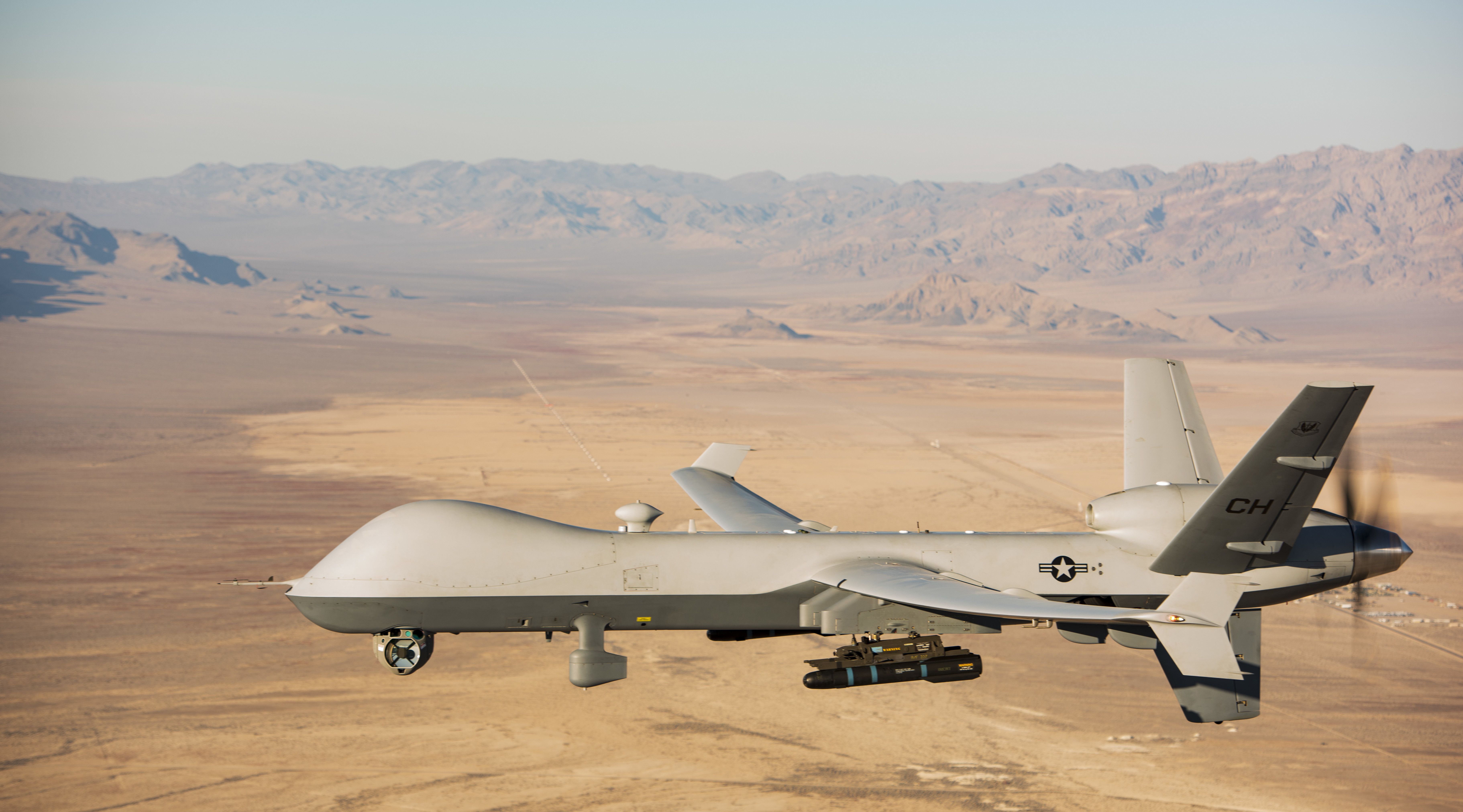
Missiles
are a major weapon of the U.S. Air Force. They can be equipped with a conventional or nuclear warhead.
Surface-launched missiles
are fired from the ground at enemy ground or air targets. The largest of these are intercontinental ballistic missiles (ICBM’s), which can travel from one continent to another. Minuteman ICBM’s can each carry three nuclear warheads. They are based in hardened silos in Montana, North Dakota, and Wyoming. America’s “nuclear triad” consists of the following three components: (1) the Air Force’s ICBM’s, (2) the Air Force’s strategic bombers, and (3) the Navy’s submarine-launched ballistic missiles.
Air-launched missiles
are carried by bombers and fighters. Air-to-ground missiles (AGM’s) are fired at targets on the ground. The Maverick is an AGM guided by a television or infrared (heat) image of a target on the ground. Other AGM’s include the High-speed Anti-Radiation Missile (HARM) and the Shrike, which destroy enemy radar by following the radar signal to its source. Air interceptor missiles (AIM’s) are used against enemy planes. The Advanced Medium-Range Air-to-Air Missile (AMRAAM) and the Sparrow are AIM’s guided by radar. Another AIM called the Sidewinder seeks the heat of the enemy aircraft’s engine.
Organization of the Air Force
The Department of the Air Force
operates under the secretary of the Air Force, a civilian directly responsible to the secretary of defense. The chief of staff, a four-star general, is the top military officer of the Air Force. This person serves on the Joint Chiefs of Staff as an adviser to the president and the secretary of defense.
However, the chief of staff does not command the Air Force in wartime. When Air Force units go to war, they are part of joint commands that include all branches of the armed forces. The Air Force chief of staff and his or her subordinates are known formally as Headquarters United States Air Force and informally as the air staff.
The Air Force has a headquarters at the Pentagon Building near Washington, D.C., and nine major commands. These units can be roughly grouped into combat commands and support commands.
Combat commands
provide forces that carry out the fighting assignments of the Air Force. A four-star general usually heads a major command. These major commands are divided into successively smaller units called air forces, wings, and squadrons. A squadron usually has 20 to 25 aircraft.
In peacetime, all combat-ready missiles, bombers, fighters, attack aircraft, and reconnaissance aircraft of the active Air Force belong to one of five commands. They are the Air Combat Command, headquartered at Langley Air Force Base, Virginia; Pacific Air Forces, headquartered at Joint Base Pearl Harbor-Hickam, Hawaii; United States Air Forces in Europe and Air Forces Africa, headquartered at Ramstein Air Base, Germany; Air Force Global Strike Command, headquartered at Barksdale Air Force Base, Louisiana; and Air Force Special Operations Command, headquartered at Hurlburt Field, Florida.
These Air Force combat commands make their forces available in wartime to joint commands. Joint commands include the Central Command for war in the Middle East and the Strategic Command for nuclear war. Air Combat Command was set up in 1992 by merging much of the Strategic Air Command with the Tactical Air Command. Air Combat Command controls most of the Air Force’s fighters, bombers, and drones. Air Force Global Strike Command has intercontinental ballistic missiles. Air Force Special Operations Command has helicopters and gunships (airplanes or helicopters armed with guns).
Support commands
help the combat commands of all the services. Air Mobility Command transports troops and supplies and also extends the range of bombers and fighters by refueling them in the air. This command was formed in 1992 when its predecessor, Military Airlift Command, gained most of the air refueling aircraft that had belonged to the Strategic Air Command. The Air Force Materiel Command, formed in 1992, buys planes, missiles, and supplies. In 1993, the Air Training Command and the Air University joined to form the Air Education and Training Command. The Air Force Reserve Command became a major command in 1997. It provides aircraft, personnel, and support to the other major commands in time of war or national emergency.
The U.S. Space Force,
a department of the Air Force, is the youngest branch of the United States armed forces. Founded in 2019, the Space Force operates military satellites and ground radar sites.
Components of the Air Force
The regular Air Force
supplies the professional core of Air Force personnel. Its size is fixed by Congress. Regular Air Force personnel include regular officers who have graduated from an officer training program and regular airmen who enlist in the service.
Air Force reserves
provide additional personnel and aircraft in emergencies. Even in times of peace, most junior Air Force officers on active duty are reservists, and reserve units perform important functions, such as air transport. The Ready Reserve consists of units and individuals trained and equipped to be called to duty in any emergency. The Standby Reserve includes personnel who can be called to duty in time of war. The Air National Guard is administered by the individual states, but can be called to duty by the president in emergencies.
Civil Air Patrol (CAP)
is a civilian auxiliary of the Air Force. It trains young people in the science of aviation and conducts search and rescue missions. See Civil Air Patrol.
History
United States military leaders sent up balloons to observe the enemy during the American Civil War (1861-1865) and the Spanish-American War (1898). But military officials did not begin to consider the airplane an important weapon until early in World War I.
Early years.
On Dec. 17, 1903, two brothers, Wilbur and Orville Wright, flew the first successful engine-powered airplane to carry a pilot. In early 1905, the Wright brothers offered to sell planes to the U.S. government, but the government did not take them seriously at first. Finally, in 1907, President Theodore Roosevelt showed interest in the airplane. That year, an Aeronautical Division was established in the office of the chief signal officer of the U.S. Army to look into the new “air machines.”
The Army bought its first airplane from the Wright brothers in 1909. In 1911, Congress appropriated the first funds for aviation—$125,000. But by 1914, when World War I erupted in Europe, the U.S. Army’s air force owned only five planes. The airplane’s military role had grown much faster in Europe. Germany had about 250 planes. France, Russia, and the United Kingdom each had over 100.
World War I (1914-1918)
pitted France, Russia, the United Kingdom, and other Allies against the Central Powers, including Germany and Austria-Hungary. Under the pressure of war, the European nations’ air forces grew rapidly to several thousand airplanes. When the United States entered the war in April 1917, the Army had fewer than 300 training planes and no combat planes. Only American pilots who already had been flying in British and French units had significant combat experience. The Lafayette Escadrille, a French squadron which included some American pilots, already boasted several aces, aviators who had shot down at least five enemy aircraft.
Not all aircraft in the war were planes. Observation balloons were used for reconnaissance. Huge, dirigible (steerable) airships—most notably the German zeppelins—could drop bombs.
At the start of the war, opposing armies used planes only to scout out enemy positions. Enemy pilots waved to each other when they passed in the sky. But soon they began to carry pistols and rifles and took potshots at each other. In 1915, a Dutch engineer, Anthony H. G. Fokker, perfected a machine gun that could fire between the revolving propeller blades. He transformed aerial warfare by making the airplane a true fighting machine. Now pilots sought enemy planes and tried to destroy them in airborne battles called dogfights.
Most of the airplanes used in World War I were small wood and canvas biplanes that had one wing above and one below the open cockpit. Plane design improved rapidly during the war. In 1914, most machines could fly only about 75 miles (120 kilometers) per hour. By 1918, planes were flying at 120 miles (190 kilometers) per hour.
As planes improved, pilots began to use them on bombing missions. At first, the pilot carried a sack of bombs in the cockpit and simply dropped them over the side. Later, mechanical devices released the bombs from under the fuselage. American pilots flew mostly French-built planes, such as Spads, Salmsons, and Nieuports. The United States produced a version of the British de Havilland D.H.4, though most of these planes did not reach the front lines.
The United States entered the war with almost no airpower, but Congress quickly appropriated $640 million for military aviation. Flying schools trained 8,688 flying cadets. Another 1,800 were trained in Europe. The 94th Pursuit Squadron entered combat in April 1918. By the end of the war, American factories produced so many planes that many people considered Allied victory inevitable. When the war ended, half of the planes on the Western Front were American. Western Front refers to battlefronts in western Europe.
American pilots destroyed about 750 enemy planes and 70 balloons. The leading American ace, Captain Eddie Rickenbacker, shot down 22 enemy planes and 4 balloons. The Allies won the war.
Between world wars.
The most prominent American air combat leader of World War I was Brigadier General Billy Mitchell. In September 1918, Mitchell had commanded nearly 1,500 American, British, French, and Italian aircraft during the Battle of St.-Mihiel in France. The air assault had helped Allied ground forces win an easy victory at St.-Mihiel.
Mitchell’s wartime experience convinced him that air units needed to be independent of ground units so that airpower could be concentrated where it could achieve the most destructive and decisive effects. In July 1921, he demonstrated the power of the airplane by sinking a former German battleship with aerial bombs. Mitchell’s criticism of the government’s defense program was so outspoken that he was court-martialed for insubordination. He chose to resign from the Army rather than accept a five-year suspension. In 1946, after developments had confirmed many of Mitchell’s ideas, he was awarded a Congressional Gold Medal.
The U.S. Army Air Service was renamed the Army Air Corps in 1926. In 1931, the first all-metal bomber was built. In 1935, the Army tested the first B-17, the Flying Fortress that would be important in World War II.
World War II (1939-1945)
was a global war in which Germany, Italy, Japan, and other Axis powers fought the Allies, who included Canada, China, the Soviet Union, the United Kingdom, and the United States. The U.S. Army Air Forces (AAF) was formed in 1941. The United States entered the war in December of that year, after Japan attacked the U.S. naval base at Pearl Harbor, Hawaii. By the time of the attack, the United States had resumed a program of building planes and training pilots.
Loading the player...Attack on Pearl Harbor
General Henry H. “Hap” Arnold was the first commander of the AAF. Under Arnold, the AAF grew to its top strength during World War II of 2,411,000 members and 80,000 planes. Aircraft used by the AAF during World War II included the P-51 Mustang long-range fighter and such bombers as the B-17, the B-24 Liberator, the B-25, and the B-29.
During the war, the AAF dropped more than 2 million tons (1.8 million metric tons) of bombs and destroyed over 40,000 enemy planes. The most destructive raids were the firebombing of Tokyo in March 1945 and the atomic bombing of Hiroshima in August 1945. The Tokyo raid killed an estimated 80,000 to 125,000 people, and the bombing of Hiroshima killed an estimated 70,000 to 100,000 people. The fact that a single atomic bomb could destroy a large city made nuclear weapons a dominating factor in U.S. military planning.
The AAF lost about 23,000 planes, about half of them in combat. Others were lost in training or other noncombat operations. About 88,000 U.S. Army aviators died in the war, which ended in an Allied victory.
Separate Air Force.
On Sept. 18, 1947, Congress created the United States Air Force as an equal partner with the Army and Navy. It also established the Department of the Air Force. Stuart Symington became the first secretary of the Air Force, and General Carl Spaatz became the first Air Force chief of staff.
The Berlin airlift
was the first big job of the new Air Force. After World War II, the Western Allies occupied western Germany, and the Soviet Union occupied the east. Berlin, in the east, was divided into Allied-occupied West Berlin and Soviet-occupied East Berlin. On June 26, 1948, Soviet troops blockaded all ground routes through the Soviet zone of occupation to West Berlin, stopping all food and supplies. The Air Force, with British and French units, supplied the city by air. Soon Allied planes were landing at Tempelhof airport every 31/2 minutes. During the 462 days of “Operation Vittles,” as U.S. pilots called it, Allied planes flew 277,000 flights carrying about 2,325,000 tons (2,109,000 metric tons) of supplies into West Berlin.
The Korean War (1950-1953)
was a local war in Korea. The United States and other members of the United Nations aided South Korea, and the Soviet Union and China assisted North Korea. The war brought the first dogfights between jet fighters. In November 1950, Air Force F-86 Sabre fighters clashed with Soviet-made MiG fighters near the Chinese border along the Yalu River. Air Force pilots called this area “MiG Alley.” They shot down 10 times as many jets as they lost there. When the Korean War ended, the Air Force had downed about 900 enemy planes and had lost 139 of its own planes in aerial combat. The Korean War ended without either side winning a complete victory. See Korean War (The air war).
The nuclear Air Force.
After Korea, the Air Force found itself undergoing rapid change. It soon had thermonuclear hydrogen bombs thousands of times more powerful than the atomic bombs that ended World War II. Propeller aircraft rapidly became obsolete for most jobs. Newer planes, such as the B-52 bomber, had jet engines and carried nuclear weapons. Intercontinental ballistic missiles could be launched from the United States and the Soviet Union.
The Vietnam War (1957-1975)
was a drawn-out conflict in Southeast Asia. In that war, the United States supported South Vietnam, and the Soviet Union and China backed North Vietnam and the Viet Cong rebels of South Vietnam. From 1961 to 1973, the United States dropped a much greater tonnage of conventional bombs in Southeast Asia than had been dropped by both sides in World War II. Most of this bombing was carried out on the territory of South Vietnam by B-52’s and fighter aircraft against Communist rebels and their North Vietnamese allies. At the same time, the United States bombed North Vietnam. It did so mostly with F-105 and F-4 fighters because it feared that China or the Soviet Union would intervene in the war if the United States bombed North Vietnam with B-52’s. The Air Force also introduced laser-guided bombs, which rarely missed their targets. The United States withdrew from Vietnam in 1973. The war ended in 1975 with a North Vietnamese and Viet Cong victory.
The Persian Gulf War of 1991.
After Iraq occupied Kuwait in August 1990, the U.S. Air Force began its most extensive airlift. In six months, the Air Force transported more than 577,000 tons (523,000 metric tons) of supplies and 498,000 military passengers as far as 7,000 miles (11,000 kilometers) to points in the Middle East. After the war began in January 1991, the Air Force flew more than 37,000 combat sorties and lost only 14 aircraft. In their first extensive use, 42 F-117 “stealth” fighter-bombers dropped hundreds of laser-guided bombs without losing a plane. The air assault so devastated the Iraqis that they surrendered in February.

The Balkans.
In Bosnia-Herzegovina, a war began in 1991 between Bosnian Serb rebels and the country’s government, which was dominated by Bosniaks (sometimes called Bosnian Muslims). In 1995, the North Atlantic Treaty Organization (NATO) intervened in the war. As part of the NATO operation, the U.S. Air Force attacked Bosnian Serb forces to help provide relief to Bosniaks under siege. Later that year, the groups involved in the war agreed to a peace treaty. In 1999, the Air Force took part in NATO air strikes against Serbia to end Serbian attacks on ethnic Albanians in its Kosovo province.
The Afghanistan War (2001-2021).
After the Sept. 11, 2001, terrorist attacks in the United States, U.S. forces waged war against the Taliban, the rulers of Afghanistan. The Taliban harbored and supported terrorists of al-Qa`ida responsible for the attacks. The campaign included air strikes by the U.S. forces to support troops on the ground and Afghan rebel groups opposed to the Taliban. The rebels overthrew the Taliban in December, but the Taliban continued to violently resist the new government of Afghanistan for years. The U.S. Air Force continued operations in Afghanistan, often using drones to gather intelligence and launch missile attacks against Taliban forces. The United States withdrew from Afghanistan in 2021. See September 11 terrorist attacks.
The Iraq War (2003-2011)
ended the rule of Iraqi dictator Saddam Hussein. Before the war began in March 2003, the Air Force airlifted troops and equipment to positions near Iraq, mostly in Kuwait. At the beginning of the war, the Air Force used precision-guided bombs to strike military targets and the leaders of Iraq’s ruling Baath Party. In April, after extensive air attacks against Iraqi ground troops, U.S.-led forces captured Baghdad, Iraq’s capital, ending Hussein’s rule. The Air Force continued to strike Iraqi targets as militants in Iraq continued to fight U.S. forces and the new Iraqi government long after the end of Hussein’s regime.
